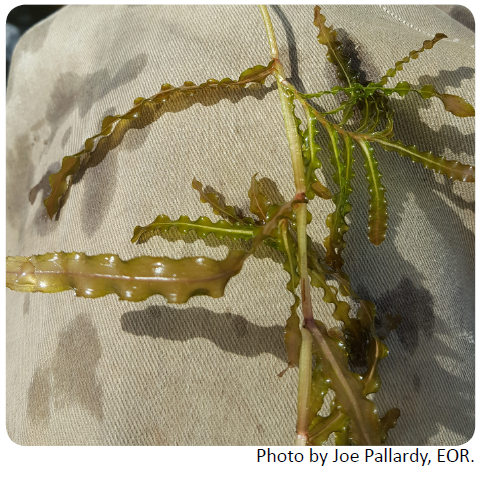Changes to the Lake
- In 2016, the water clarity dramatically improved, which allowed more sunlight to the bottom and helped aquatic plants grow.
- Aquatic plants help to keep the water clear, which is a preferred state. It is expected that the growth of plants will lesson as the lake reaches a better balance. However, a large growth of aquatic plants makes it difficult to canoe, boat, fish or swim. Intense plant growth tends to begin to die back after the 4th of July.
Good Plants
- Main species present is Fern-leaf pondweed. This is a good plant for the lake. The pondweed flowered in late June, and the seeds on the flowers provide valuable food for wildlife.
- Other good plants that were found include white water-lily and Canadian waterweed.

Fern-leaf pondweed
Leaf: Has olive-green to brown leaves. The leaves are stiff and linear, and single leaves are attach in an alternating
pattern around the stem.
Habitat: Fern-leaf pondweed grows completely underwater in shallow waters up to 15 feet deep.
Flower: Small flowers with 4 petals on spikes near the surface of the water.
Value: Provides food and cover for aquatic animals and waterfowl.
Not-So-Good Plants
- Curly-leaf Pondweed was also found, which is an invasive species (not naturally found in Minnesota lakes) and can harm the lake. It is important to be careful to not provide places for it to grow, as it can begin growing under the ice in the spring and out-compete native plants.
- The best way to deter Curly-leaf Pondweed is to help native plants grow. If an herbicide treatment is considered, it must be done early - such as late April or early May.
- Remember to clean, drain, and dry your boats and docks!!! Stop the spread of curly-leaf pondweed to other lakes.

Curly-leaf pondweed
Leaf: Has olive-green to brown leaves. The leaves have distinct “teeth” and wavy edges. They are also attached in an alternating pattern to the stem, but may have multiple leaves.
Habitat: Curly-leaf pondweed grows completely underwater in shallow waters up to 15 feet deep. It is generally the first pondweed to come up in the spring, and dies back in the midsummer.
Turions: Curly-leaf produces turions, or small buds that look like greenish-brown pinecones.
Value: This plant is INVASIVE and harmful to lake ecosystems. It has been seen in the areas around docks where landowners have attempted to remove aquatic plants, especially along the south shore. The best way to deter Curly Leaf Pondweed is to help native plants grow.
